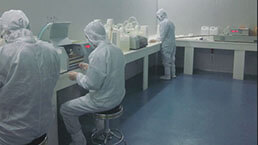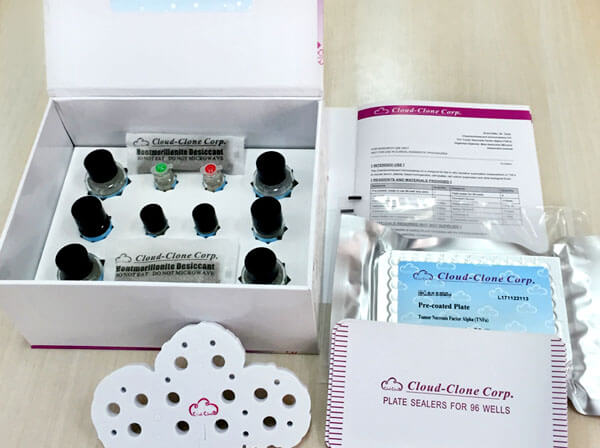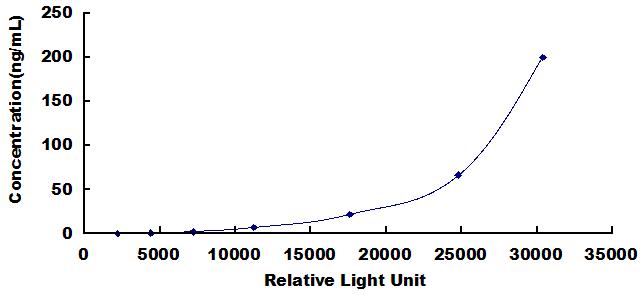CLIA Kit for Elastin (ELN) 

WBS, WS, SVAS; Tropoelastin; Supravalvular Aortic Stenosis; Williams-Beuren Syndrome
- UOM
- FOB US$ 636.00 US$ 908.00 US$ 4,086.00 US$ 7,718.00 US$ 63,560.00
- Quantity
Overview
Properties
- Product No.SCB337Bo
- Organism SpeciesBos taurus; Bovine (Cattle) Same name, Different species.
- ApplicationsChemiluminescent immunoassay for Antigen Detection.
Research use only - DownloadInstruction Manual
- CategoryMetabolic pathwayDevelopmental science
Sign into your account
Share a new citation as an author
Upload your experimental result
Review

Contact us
Please fill in the blank.
Recovery
Matrices listed below were spiked with certain level of recombinant Elastin (ELN) and the recovery rates were calculated by comparing the measured value to the expected amount of Elastin (ELN) in samples.
| Matrix | Recovery range (%) | Average(%) |
| serum(n=5) | 93-102 | 98 |
| EDTA plasma(n=5) | 80-103 | 87 |
| heparin plasma(n=5) | 93-103 | 101 |
Precision
Intra-assay Precision (Precision within an assay): 3 samples with low, middle and high level Elastin (ELN) were tested 20 times on one plate, respectively.
Inter-assay Precision (Precision between assays): 3 samples with low, middle and high level Elastin (ELN) were tested on 3 different plates, 8 replicates in each plate.
CV(%) = SD/meanX100
Intra-Assay: CV<10%
Inter-Assay: CV<12%
Linearity
The linearity of the kit was assayed by testing samples spiked with appropriate concentration of Elastin (ELN) and their serial dilutions. The results were demonstrated by the percentage of calculated concentration to the expected.
| Sample | 1:2 | 1:4 | 1:8 | 1:16 |
| serum(n=5) | 87-104% | 90-99% | 95-103% | 78-90% |
| EDTA plasma(n=5) | 83-101% | 90-98% | 97-105% | 80-94% |
| heparin plasma(n=5) | 82-98% | 98-105% | 78-93% | 94-101% |
Stability
The stability of kit is determined by the loss rate of activity. The loss rate of this kit is less than 5% within the expiration date under appropriate storage condition.
To minimize extra influence on the performance, operation procedures and lab conditions, especially room temperature, air humidity, incubator temperature should be strictly controlled. It is also strongly suggested that the whole assay is performed by the same operator from the beginning to the end.
Reagents and materials provided
| Reagents | Quantity | Reagents | Quantity |
| Pre-coated, ready to use 96-well strip plate | 1 | Plate sealer for 96 wells | 4 |
| Standard | 2 | Standard Diluent | 1×20mL |
| Detection Reagent A | 1×120µL | Assay Diluent A | 1×12mL |
| Detection Reagent B | 1×120µL | Assay Diluent B | 1×12mL |
| Substrate A | 1×10mL | Substrate B | 1×2mL |
| Wash Buffer (30 × concentrate) | 1×20mL | Instruction manual | 1 |
Assay procedure summary
1. Prepare all reagents, samples and standards;
2. Add 100µL standard or sample to each well. Incubate 1 hours at 37°C;
3. Aspirate and add 100µL prepared Detection Reagent A. Incubate 1 hour at 37°C;
4. Aspirate and wash 3 times;
5. Add 100µL prepared Detection Reagent B. Incubate 30 minutes at 37°C;
6. Aspirate and wash 5 times;
7. Add 100µL Substrate Solution. Incubate 10 minutes at 37°C;
8. Read RLU value immediately.

Test principle
The microplate provided in this kit has been pre-coated with an antibody specific to Elastin (ELN). Standards or samples are then added to the appropriate microplate wells with a biotin-conjugated antibody specific to Elastin (ELN). Next, Avidin conjugated to Horseradish Peroxidase (HRP) is added to each microplate well and incubated. Then the mixture of substrate A and B is added to generate glow light emission kinetics. Upon plate development, the intensity of the emitted light is proportional to the Elastin (ELN) level in the sample or standard.;
Giveaways
Increment services
-
 Single-component Reagents of Assay Kit
Single-component Reagents of Assay Kit
-
 Lysis Buffer Specific for ELISA / CLIA
Lysis Buffer Specific for ELISA / CLIA
-
 Quality Control of Kit
Quality Control of Kit
-
 CLIA Kit Customized Service
CLIA Kit Customized Service
-
 Disease Model Customized Service
Disease Model Customized Service
-
 Serums Customized Service
Serums Customized Service
-
 TGFB1 Activation Reagent
TGFB1 Activation Reagent
-
 Real Time PCR Experimental Service
Real Time PCR Experimental Service
-
 Streptavidin
Streptavidin
-
 Fast blue Protein Stain solution
Fast blue Protein Stain solution
-
 Single-component Reagents of FLIA Kit
Single-component Reagents of FLIA Kit
-
 Streptavidin-Agarose Beads
Streptavidin-Agarose Beads
Citations
- Induction of elastin expression in vascular endothelial cells relates to hepatoportal sclerosis in idiopathic portal hypertension: possible link to serum anti-endothelial cell antibodiesPubMed: 22288597
- Protein synthesis and secretion in human mesenchymal cells derived from bone marrow, adipose tissue and Wharton's jelly.Pubmed: 24739658
- A dietary supplement improves facial photoaging and skin sebum, hydration and tonicity modulating serum fibronectin, neutrophil elastase 2, hyaluronic acid and carbonylated proteinsPubmed:25732262
- Mesenchymal stromal cell proliferation, gene expression and protein production in human platelet-rich plasma-supplemented mediaPubmed:Pmc4130592
- Effects of Exendin-4 on human adipose tissue inflammation and ECM remodelling.pubmed:27941938
- Anti-ageing effects of Ubiquinone and Ubiquinol in a senescence model of human dermal fibroblasts33482334
- GENE THERAPY DNA VECTOR VTvaf17, METHOD OF PRODUCTION; ESCHERICHIA COLI STRAIN SCS110-AF, METHOD OF PRODUCTION; ESCHERICHIA?¡
- CLINICAL SIGNIFICANCE OF LAMININ AND ELASTINE LEVELS IN CHILDREN WITH UNDIFFERENTIATED CONNECTIVE TISSUE DISEASE








